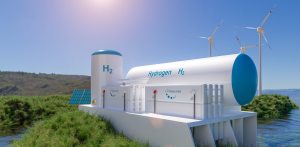Decarbonising Industrial Parks: A Strategic Imperative

Tan Wooi Leong
Managing Director, Surbana Jurong
Dennis Tan Kok Meng
Senior Director (Energy & Industrial), Surbana Jurong
Feng Zhefei
Senior Executive Engineer (Energy & Industrial), Surbana Jurong
Saiful Hasif Abdul Rani
Analyst (Industrial Parks), Energy & Industrial, Surbana Jurong
The drive for industrialisation continues to escalate as nations across the world strive for growth and aspire to bring majority of their population to respectable income levels.
Over the past two decades, many agrarian economies have transitioned towards industrial activities. As more parts of the world become urbanised, the demand for energy shall increase further. The world’s hunger for more energy stands in stark contrast to the Net Zero Emission goals pledged by nations. The only way to solve this riddle is to gradually shift towards low-carbon sources of energy such as solar, wind, hydrogen and ammonia. Globally, the industrial sector is a huge wealth generator as companies make materials and goods that are integral to our daily lives. Industrial parks, where large-scale facilities for energy production, electricity distribution, goods manufacturing and transportation are co-located, are key geographical hubs of economic and industrial activity.
Accounting for 15 to 20 percent of global CO2 emissions, industrial clusters have been a critical target for emissions reductions. The alarming proportion of emissions signifies that there is an urgent need to decarbonise industrial parks, where emissions-intensive industrial activities take place. Decarbonising industrial parks will also create new opportunities for innovation and technology in the areas of renewable energy, energy storage and low-carbon transportation as well as the deployment of various technologies including carbon capture, utilisation and storage (CCUS). This will help to enhance the competitiveness of businesses in industrial parks across the global markets.

Hydrogen, the Pathway to Decarbonisation
When considering the strategic imperative of decarbonising industrial parks, it is likely that a clean low-carbon fuel such as hydrogen will be needed to provide the critical long-term solution. Solar and wind energy show great promise as power generation alternatives, but they face challenges such as recycling issues for solar panels and dependence on weather patterns for wind energy. To address these limitations, alternative fuels like ammonia and hydrogen are being explored, backed by favorable regulatory regimes and technological advancements. Ammonia, although cheaper to produce, poses toxicity concerns, limiting its widespread use. On the other hand, hydrogen, while non-toxic, demands greater energy for production, storage, and transport. A balanced approach, integrating various renewable energy sources, is key to shaping a sustainable energy future. By leveraging strengths and overcoming drawbacks, we can work towards a greener and more resilient energy landscape.
Hydrogen could become the zero-carbon substitute for fossil fuels, especially in hard-to-abate sectors of the economy. It can be utilised for power generation and industrial processes. The clean burning fuel is versatile, reactive, storable and transportable. Facilities that currently rely on natural gas can switch to clean hydrogen by upgrading or retrofitting existing natural gas systems. The cost of producing green hydrogen from renewables and blue hydrogen from fossil fuels with carbon capture will decrease over time, but demand needs to be created to drive down costs, and a wide range of delivery infrastructure needs to be built.
New government targets, policies, and subsidies are essential for making this a reality. As at 2022, the total number of governments that have committed to adopt hydrogen as a clean energy vector in their energy system has risen to 26 according to the International Energy Agency (IEA). GHG emissions from industrial clusters are generally accepted to be one of the hardest to abate, and therefore the adoption of clean hydrogen must be leveraged.
In the coming decades, industrial parks, such as petrochemical hubs, will decarbonise via these key channels: the reduction of fossil fuel-based refinery operations; the electrification of processes where feasible; and where electrification is technically impractical, large petrochemical units will be fuelled by hydrogen rather than natural gas.
A hydrogen pipeline common infrastructure will eventually be developed in mature industrial parks that will host a diverse variety of heavy industries. This will primarily be led by private-sector consortiums and funded by local governments. The pipeline infrastructure could run along pipeline corridors within the industrial park, and ultimately even link up parks across single land masses.
Hydrogen enriched natural gas (HENG) will also play a key role in the transition of natural gas towards hydrogen fuel for power generation. The blend will enable clean hydrogen to be transferred through existing natural gas pipelines. The sources of hydrogen could be either green or blue hydrogen, or a combination, both imported and locally produced. As such configurations take shape around the world, it would spur the creation of new supply chain routes and infrastructure for hydrogen transportation by sea. New ultra cryogenic vessels would be required to transport hydrogen in liquefied form (known as LH2) at -253°C. Hydrogen can also be transported via other energy carriers such as ammonia, liquid organic hydrogen carriers (also known as LOHC) or methyl cyclohexane (also known as MCH).
Decarbonising Industrial Parks: Factors to Consider
Clean hydrogen needs to be scaled up to support a green future
Hydrogen is not the cure-all yet, as most of the hydrogen in use today is generated using fossil fuels, which emits CO2 into the atmosphere and contributes to the climate crisis. Natural gas is currently the primary source of hydrogen production, accounting for around three quarters of the annual global dedicated hydrogen production of around 70 million tonnes.
The IEA has identified four near-term opportunities to boost hydrogen on the path towards its clean, widespread use: make industrial ports the nerve centres for scaling up the use of clean hydrogen; build on existing infrastructure, such as millions of kilometres of natural gas pipelines; expand hydrogen in transport through fleets, freight and corridors; and launch the hydrogen trade’s first international shipping routes. Focusing on these real-world springboards could help hydrogen achieve the necessary scale to bring down costs and reduce risks for governments and the private sector. While each opportunity has a distinct purpose, all four also mutually reinforce one another. Clean hydrogen therefore needs to be scaled up to support a clean energy future.

The 7 pillars of Energy Transition and Decarbonisation are:
- Operational Efficiency
- Natural Gas Shift
- Low-Carbon Power/Utilities
- Low-Carbon Fuels/Material
- Carbon Capture Utilisation and Storage
- Natural Sinks
- Behavioural Change
Decarbonising industry means reimagining production processes
Data scarcity is a challenge in decarbonising industrial parks. GHG mitigation of industrial parks and energy infrastructure have been mostly investigated and analysed separately, and very few studies have studied and addressed the topic of energy infrastructure decarbonisation at the industrial park level. The infrastructure powering industrial parks is defined as shareable utilities that are located within the park and provide energy e.g., heat and electricity, for the park and the wider spaces beyond them. This infrastructure links energy, water, and pollutants together. For most industrial parks, applicable GHG mitigation measures can be implemented from the perspective of energy infrastructure but hurdles remain.
The challenge is that many industrial parks have existing energy infrastructure that relies heavily on fossil fuels. Retrofitting or replacing this infrastructure with clean alternatives can be expensive and time-consuming. The process of decarbonising industry demands reimagining production processes from scratch, and redesigning existing sites with costly rebuilds or retrofits. Companies that adopt low-carbon production processes will see a short- to mid-term increase in cost, which may place them at an economic disadvantage in a global commodities market. It is also vital to note that industrial parks typically have a high energy demand due to the presence of energy-intensive industries such as manufacturing, refining, and chemical production.
Government participation is vital
The participation by governments and collaboration with industry is absolutely essential to accelerate the transition of industrial parks globally towards net-zero emissions. Governments can create favourable conditions that attract investment and build confidence in developing collaborations such as the Transitioning Industrial Clusters towards Net Zero initiative.
Support that is offered in the initiative includes public-private and cross-industry partnerships. This is the channel where government participation is needed especially from legislators and regulators. In-depth, country-specific policy and public funding analyses, roundtables with policy-makers and financial sector leaders, and exchange of best practices and tools to build public-private engagement can be implemented. For example, the authorities of a country could consider upgrading its national green standards and promote green industrial parks by introducing more ambitious targets and incentives; improving data collection and analysis systems to track and streamline performance of industrial park against domestic and international standards; strengthening enforcement of regulations and leveraging policy enablers such as adopting a specific law on Industrial Park Management.
Governments can also provide incentives for Scope 3 supply chain decarbonisation to accelerate carbon-neutrality implementation. Decarbonisation within the supply chain plays a critical role in realising comprehensive net-zero ambitions, and businesses are in a unique position to influence supplier behaviors, operations and investments through the incentives.
Conclusion
As countries try to deliver on net zero pledges, policymakers are scrambling to find sustainable alternatives to fossil fuels to decarbonise heavy industry. Industries like steel, cement and petrochemicals are amongst the top sources of emissions globally and are intrinsically difficult to decarbonise. To this end, several major economies including the United Kingdom, Canada and the Netherlands are providing funding to support the deployment of hydrogen and CCUS projects into high-emitting industrial clusters and engaging in policy and business model experimentation to reduce carbon emissions, notes the IEA. Underpinning this activity is the hope that the economies of scale, opportunities for joint efficiencies and potential for shared learning provided by clusters will kick-start the industrial transition, anchoring early demand and fostering an initial market for low-carbon technologies.
To be an effective clean low-carbon fuel, the industrial sector is reliant on ramping up both the demand and supply of green and blue hydrogen. Building up the political capital, renewables capacity and overcoming technical challenges to scaling the technology to play a major role in decarbonising heavy industry will, however, likely take decades.
The challenge for countries looking to rapidly mobilise resources and capital for hydrogen production is therefore significant. Policymakers have a key role to play in creating a favourable regulatory environment, which incentivises the development of hydrogen-ready infrastructure and spurs innovation.
Explore our decarbonisation projects in the region: https://surbanajurong.com/service/energy/



